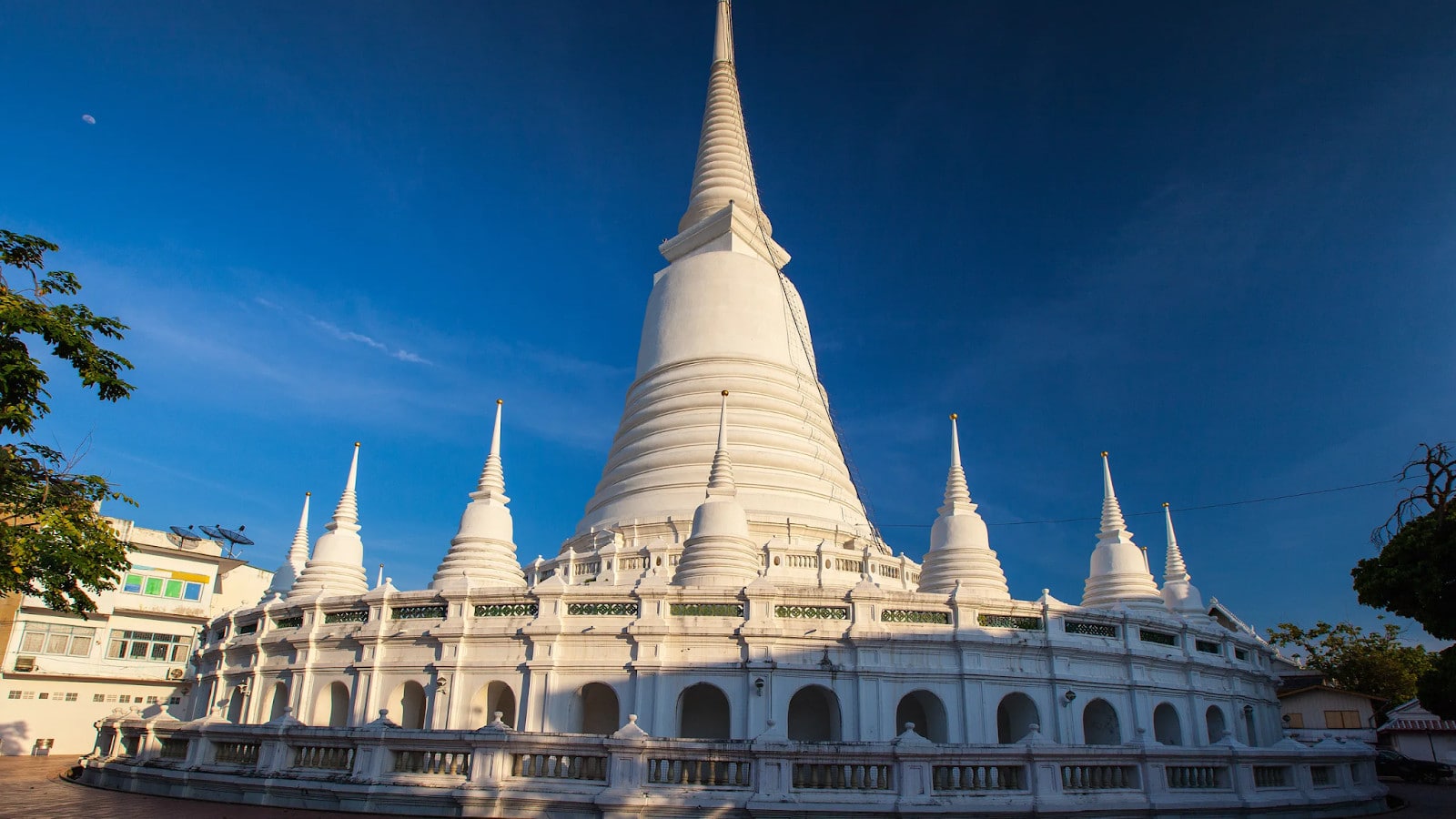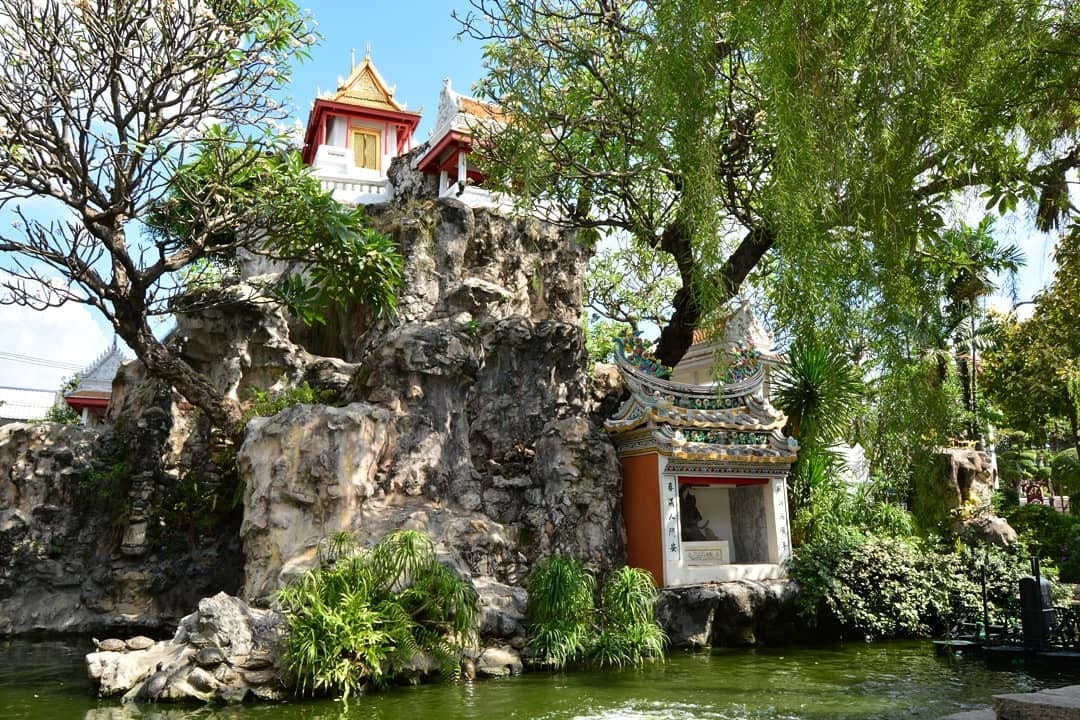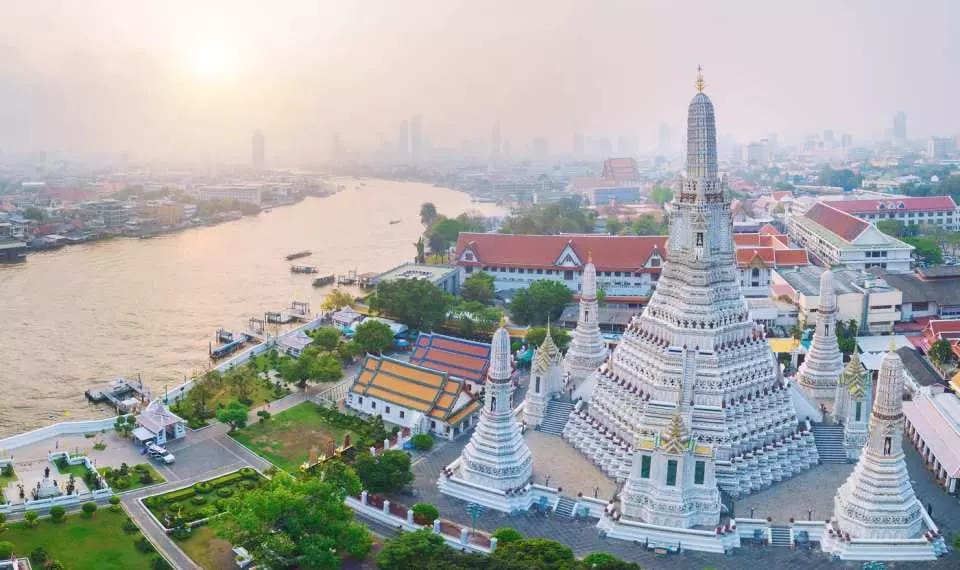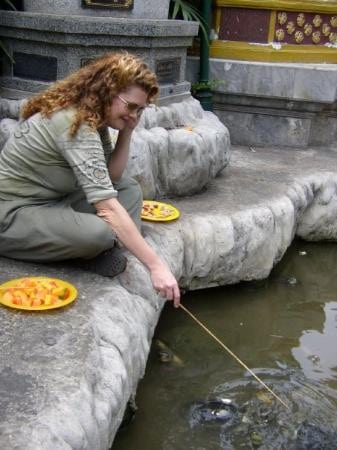Table of Contents
Tucked away on the banks of the Chao Phraya River, tourists often overlook this hidden gem, but it’s definitely worth a visit.
With its tranquil surroundings, unique architecture, and rich history, Wat Prayoon is a must-visit destination for anyone exploring Bangkok’s spiritual and cultural heart.

History of Wat Prayoon
Wat Prayoon, also known as Wat Rua Lek, was built during the reign of King Rama III in the early 19th century.
The temple was built to honor his niece, Princess Chak Su Ratchawadi, who passed away at a young age.
King Rama III ordered the construction of the temple and its surrounding fortifications to protect the city from potential invasions by foreign powers.
The temple was initially used as a royal crematorium and later became a place of worship.
The temple has undergone various renovations over the years, with the most significant renovation taking place in the 1980s, which restored much of the temple’s original architecture and artwork.
Today, Wat Prayoon remains an important site of religious and cultural significance in Bangkok, attracting locals and tourists alike.

Unique Architecture
The architecture of Wat Prayoon is unique and striking, with a mixture of Thai and Chinese styles.
A white wall with small turrets surrounds the temple, and a towering, colorful pagoda is at the center of the temple complex.
The pagoda is decorated with intricate carvings and statues of Buddha and is surrounded by a pond filled with lotus flowers.
The pond is accessible by a small bridge, which adds to the temple’s serene atmosphere.
The temple’s architecture also includes a unique turtle shrine, which is said to bring good luck to those who toss coins into the water surrounding it.
Small pagodas and a beautiful archway surround the turtle shrine.
Overall, the architecture of Wat Prayoon is a beautiful blend of Thai and Chinese styles and is definitely worth a visit for anyone interested in exploring the unique temples of Bangkok.

Tranquil Surroundings
The surroundings of Wat Prayoon are incredibly tranquil and peaceful, making it the perfect place to escape the hustle and bustle of Bangkok.
The temple is surrounded by lush greenery, including tall trees and vibrant plants, which add to the area’s natural beauty.
Additionally, the temple is located on the banks of the Chao Phraya River, offering visitors scenic views of the river and its surroundings.
The lack of large crowds of tourists further enhances the peaceful ambiance of Wat Prayoon.
Unlike some of the more popular temples in Bangkok, Wat Prayoon is often overlooked by tourists, allowing visitors to explore the temple and its grounds.
This makes it an ideal destination for those looking to connect with their spirituality, meditate, or simply relax in a serene environment.
The pond surrounding the towering pagoda is filled with lotus flowers, adding to the peaceful and serene atmosphere of the temple.
Visitors can take a stroll around the pond or simply sit and enjoy the area’s tranquility.
The giant turtle shrine, located on the temple grounds, also adds to the peacefulness of the surroundings, as visitors toss coins into the water surrounding the shrine, creating a soothing sound.
The combination of lush greenery, scenic river views, and lack of large crowds make Wat Prayoon the perfect place to relax, meditate, or simply enjoy the serene atmosphere.

What to See at Wat Prayoon
Here are some of the things you can see when you visit the temple:
Chedi
The chedi at Wat Prayoon, also known as Phra Borommathat Maha Chedi, is one of the temple’s most notable features.
It is a large, white, bell-shaped structure that stands 60 meters tall and is surrounded by 36 smaller chedis, each containing a Buddha image.
The chedi’s design is inspired by the classic Ayutthaya-style architecture, popular in Thailand during the 16th century.
It has a square base that gradually tapers upwards to a rounded top. The chedi is covered with white stucco and decorated with intricate patterns and designs.
At the base of the chedi, there are several levels that visitors can explore.
The first level features four entrances, each guarded by giant demons. Inside are murals and paintings depicting the life of the Buddha and various Buddhist teachings.
The second level is accessible by a staircase and features a small shrine containing a Buddha image.
The third level houses a larger Buddha image and a sacred Buddhist relic chamber.
At the very top of the chedi is a gold-plated spire that is said to contain a Buddha relic.
Visitors can climb to the top of the chedi for a breathtaking view of the temple grounds and the surrounding area.

Ordination Hall
The Ordination Hall, also known as the ubosot, at Wat Prayoon is a magnificent building located on the temple grounds.
The hall is the most sacred building in the temple, and it is used for critical Buddhist ceremonies, such as ordinations and weddings.
The Ordination Hall is a rectangular-shaped building with a steeply sloping roof adorned with golden ornaments and intricate carvings.
Two golden Naga serpent statues guard the hall’s front entrance, and four golden pillars are on each side of the entrance.
Inside the hall, the walls and ceiling are covered with elaborate murals depicting scenes from the life of the Buddha and the Jataka tales.
The murals were painted by the renowned Thai artist, Khrua In Khong, and they are considered some of the finest examples of traditional Thai art.
The hall’s centerpiece is the main Buddha image, which is seated on a golden pedestal and surrounded by smaller Buddha images.
The image is made of bronze and covered with gold leaf, and devotees highly revere it.
Visitors to the Ordination Hall are required to remove their shoes and dress modestly out of respect for the sacredness of the space.
The hall provides a peaceful and contemplative atmosphere, and it is a wonderful place to learn more about the teachings and practices of Buddhism.

Giant Turtle
On the temple grounds, you can see a giant turtle shrine, believed to bring good luck and fortune to those who pay their respects.
The shrine is located on the temple grounds, a popular spot for locals and tourists to pay their respects and make offerings.
The giant turtle shrine consists of a large stone turtle about 3 meters long and 2 meters wide.
The turtle is covered in gold leaf and is adorned with colorful flowers, candles, and incense sticks.
According to Thai Buddhist belief, the turtle symbolizes longevity, good fortune, and prosperity.
It is also associated with the story of the Buddha’s previous life, where he was said to have been reborn as a turtle.
Visitors can offer food and coins to the turtle and feed the smaller turtles that live in the pond next to the shrine.
It is believed that making offerings to the turtle can bring good luck and blessings to those who do so.

Boat Museum
The Boat Museum at Wat Prayoon, also known as the National Museum of Royal Barges, is a fascinating exhibit of traditional Thai boats located within the temple grounds.
Here’s what you can expect to see at the Boat Museum:
The museum features a collection of traditional Thai boats, including long-tail boats, fishing boats, and rice barges.
Many of the boats are intricately decorated with bright colors and intricate carvings.
It also houses several impressive royal barges once used in important ceremonies and processions.
These barges are elaborately decorated with gold leaf, glass mosaics, and intricate carvings.
Here you can glimpse Thailand’s maritime history and the importance of boats in Thai culture.
Visitors can learn about the different types of boats used for transportation, trade, and fishing and the symbolism and significance of the royal barges.
The museum offers an audio guide in several languages to give visitors a more in-depth understanding of the boats and their historical and cultural significance.

Gardens
The gardens at Wat Prayoon, also known as Wat Rua Lek, are a serene and picturesque oasis in the heart of Bangkok.
The temple grounds cover an area of about 4 acres, and a large portion of this space is devoted to gardens and greenery.
As you enter the temple grounds, you will be greeted by a long avenue of trees leading to the main temple buildings.
Along the way, you will see lush green lawns, vibrant flowers, and meandering paths that wind through the gardens.
The gardens are home to several large ponds and water features decorated with lotus flowers, lilies, and other aquatic plants.
Visitors can sit by the water and enjoy the tranquil atmosphere or feed the fish that swim in the ponds.
The gardens also feature several sculptures and statues, including a large bronze statue of King Rama III, who was responsible for the temple’s construction.
The king is depicted seated on a throne, with his hand resting on a sword.
In addition to the gardens, visitors can enjoy the views of the Chao Phraya River, which flows past the temple on the western side.
The river provides a stunning backdrop to the gardens, and visitors can stroll along the riverbank to enjoy the scenery.
How to Reach Wat Prayoon
Wat Prayoon is located in Thonburi, on the west bank of the Chao Phraya River. The easiest way to get to the temple is by taking a taxi or tuk-tuk.
The temple is open daily from 9 am to 5 pm, with no entrance fee. However, donations are appreciated to help maintain the temple.
You can also consider the following transportation to reach Wat Prayoon:
By Public Transportation
Take the MRT (subway) to Hua Lamphong station. From the station, take a taxi or a tuk-tuk to Wat Prayoon. The temple is about 4 kilometers away from the station.
By Boat
Take the Chao Phraya Express Boat to the Memorial Bridge Pier (Saphan Phut Pier). Take a short walk from the pier to the temple on the river’s west bank.

By Car or Taxi
If you are driving or taking a taxi, the temple is on the Thonburi side of the Chao Phraya River. You can use Google Maps or a GPS navigation system to guide you to the temple.
Wrapping Up
In conclusion, Wat Prayoon is a hidden gem in Bangkok that offers visitors a unique and tranquil experience.
With its beautiful architecture, rich history, and serene surroundings, it’s no wonder that this temple is a favorite among locals. If you’re looking for a peaceful escape from the hustle and bustle of Bangkok, Wat Prayoon is the perfect destination.
Just like Wat Prayoon in Bangkok, Wat Kathu in Phuket is also a hidden gem that offers visitors a chance to escape from the hectic pace of everyday life.
So, whether you’re looking for a cultural experience or a beach vacation, consider including Phuket on your itinerary.


